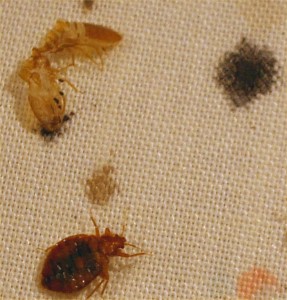How Do Bed Bugs Feed on Humans
Bed Bugs - What They Are and How to Control Them
Bed bugs have been around for thousands of years. They feed on blood, but are not known to spread any diseases to humans. Some people can be allergic to their bites. Getting rid of a bed bug infestation is not easy, but there are steps you can take to control the problem. There are also steps you can take to avoid bringing bed bugs home.
What are bed bugs?

- Bed bugs are small, flat wingless insects that are reddish-brown in color and approximately one-quarter inch long, before feeding (about the size and shape of a small apple seed).
- They hide during the day on beds (mattress seams, box springs, bed frames, headboards) and in cracks and crevices of walls, floors and furniture. They come out at night.
- They do not fly or jump, but they can crawl rapidly.
How can bed bugs get into my home?
- They can come from other infested areas or from used furniture. They can hitch a ride in luggage, purses, backpacks, or other items placed on soft or upholstered surfaces.
- They can travel between rooms in multi-unit buildings, such as apartment complexes and hotels.
How can I avoid bringing bed bugs into my home?
- When staying in a hotel, place your bag on a suitcase stand rather than on the bed or floor. Keep the rack away from walls or furniture. When returning home, wash the clothes from your trip and put them in a hot dryer.
- Inspect new and used furniture before bringing it inside. Look in seams, tufts and under cushions.
How do I know if I have a bed bug problem?
- You can see the bed bugs themselves, their shed skins, or their droppings in mattress seams and other items in the bedroom.
- There may also be blood stains on sheets.
How do I control a bed bug problem in my home?
It can be done, but it usually requires what is called an "integrated pest management" (IPM) approach. This combines techniques that pose the lowest risk to your health and the environment. Try these strategies:
- Clean and get rid of clutter, especially in your bedroom.
- Move your bed away from walls or furniture.
- Vacuum molding, windows and floors every day. Vacuum sides and seams of mattresses, box springs and furniture. Empty the vacuum or the bag immediately and dispose of outside in a sealed container or bag.
- Wash sheets, pillow cases, blankets and bed skirts and put them in a hot dryer for at least 30 minutes. Consider using mattress and box spring covers –the kind used for dust mite control–and put duct tape over the zippers.
- Seal cracks and crevices and any openings where pipes or wires come into the home.
Should I also try pesticides?
Pesticides may not be effective and can be dangerous if used improperly. If you decide to use pesticides, follow these rules:
- Only use pesticides that are registered by the U.S. Environmental Protection Agency (look for the U.S. EPA Registration Number on the label) and make sure they are labeled to control bed bugs.
- Do not apply pesticides directly to your body (there are no repellents registered to control bed bugs that can be used on the human body).
- Do not use outdoor pesticides indoors.
- If you decide to hire a pest control company, make sure they have experience with bed bugs. They should follow the steps of IPM, along with any pesticide application. Use a company that is registered and employs licensed applicators. The Department of Environmental Conservation has a list of registered companies.
It takes time and persistence to get rid of bed bugs, and in some cases, the cooperation of landlords, neighbors and others. It can be physically and emotionally exhausting. It can also be expensive when pest control companies are called in. Just remember - bed bugs are more of a nuisance than a health concern and, with vigilance, you can avoid or deal with infestations.
If you are a renter, the Residential Tenants' Rights Guide can explain many of the laws that can help you and provide resources where you can find more information about landlord and tenant issues, like bed bug infestations.
See the following for more information on bed bug biology and control measures:
- Cornell University-NYS Integrated Pest Management Program
- New York City Department of Health and Mental Hygiene
- U.S. Centers for Disease Control and Prevention and U.S. EPA Joint Statement on Bed Bug Control in the United States
Photo courtesy of Dr. Harold Harlan, Armed Forces Pest Management Board Image Library
Source: https://www.health.ny.gov/environmental/pests/bedbugs.htm
0 Response to "How Do Bed Bugs Feed on Humans"
Postar um comentário